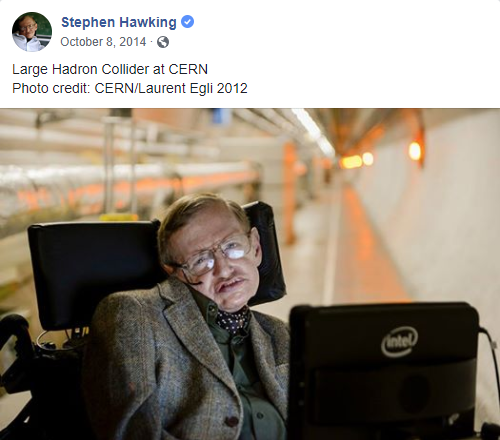Summary: Intelligent life fills third place in 10 answered questions that theoretical physicist Stephen Hawking fits into Brief Answers to the Big Questions.
 |
| Stephen Hawking favors carbon- over silicate-formulated forms; predicted sizes of differently-composed planets graphic: Marc Kuchner/NASA GSFC, Public Domain, via NASA Goddard Space Flight Center |
Intelligent life advances to third among the 10 questions asked and answered in a posthumous publication Oct. 15, 2018, acknowledged as the last by a world-renowned theoretical physicist and university mathematics professor.
Stephen Hawking (Jan. 8, 1942-March 14, 2018) broaches "Is there other intelligent life in the universe?" in Chapter 3 of Brief Answers to the Big Questions. The eldest child of a tropical medicine researcher and a secretary commences with the second law of thermodynamics concerning more ordered components of more disordered totalities. He defines life as "an ordered system that can keep itself going against the tendency to disorder and can reproduce" into "similar, but independent, ordered systems."
The co-author with daughter Lucy Hawking of the five-book George's cosmic adventure series explains that genes and metabolism respectively educate humankind and effectuate endurance and reproduction.
Hawking favors carbon-formulated over silicon-formulated forms from the former's "richest chemistry" in a fine-tuned universe for carbon-friendly electric charge, quantum chromodynamics (QCD) scale and space-time dimension.
The Big Bang 13.8 billion years ago generated equal-numbered neutrons and protons until temperatures got to 1 billion degrees Celsius and Kelvin (1.8 billion degrees Fahrenheit). The expanding universe and falling temperatures harvested nothing, without atoms herding into molecules, that heralded living systems: protons from decaying neutrons; one-proton hydrogen; two-neutron two-proton helium. The cooling, expanding universe included denser intervals whose gravitational attraction inhibited their cool expansion and initiated galaxies and stars 2 billion years after the Big Bang.
The hotter, more massive stars jump-started helium and hydrogen burning into heavier, living system-friendly elements such as carbon, iron and oxygen within another 300-plus million years.
One-fifth of all stars keep at Earth-like distances Earth-like planets with life perhaps compatible with the solar system's kickstart 9.3-plus billion years after the Big Bang.
Earthly fossils lauded deoxyribonucleic acid (DNA) molecules, multi-cellular organisms, fish and mammals, and humankind within another 1 billion, 2.5 billion, 1 billion and 100 million years. Humankind for the last 10,000 years, 13.79 billion years after the Big Bang, manage external-transmitted, internal-transmitted evolution by books and long-term information-storing and by random mutations. Hawking notes, by 2100, self-designed evolution nudging aggressive, self-destructive humankind into disease-resistant, even-tempered, long-lived, maximum-memory superhuman navigators at the speed of light to other planetary niches.
Hawking observes earthly intelligent life, within 100,000 years, obliterating non-self-designing humankind and obsolesced by advanced extraterrestrial civilizations, genetically engineered viruses, nuclear war and unstable greenhouse effects.
Procrastinated presences of earthly non-intelligent life 10.3 billion years after the Big Bang persuade Hawking of extraterrestrial, non-intelligent life as more probable than extraterrestrial intelligent life.
Life's rare spontaneous generation and intelligent life's extinction during asteroid/comet-planet collisions every 20 million years, rare evolution from self-reproducing systems and self-destruction quash extraterrestrial life's sustainability. The launch participant of Breakthrough Listen Initiatives in 2015 reveals a fourth reason for intelligent life as seemingly Earth-restricted in remaining overlooked by extraterrestrial intelligent life. The Breakthrough research program's radio telescopes seek extraterrestrial intelligent life for sharing Breakthrough Message series after, Hawking suggests, not before, "we have developed a bit further."
Hawking terms earthly intelligent life as: overlooked by advanced, threatening extraterrestrial life; self-destructive; succeedable by electro-mechanical, non-macromolecular life; survivalistic another 100,000 years or indefinitely; universally rare.
Acknowledgment
My special thanks to talented artists and photographers/concerned organizations who make their fine images available on the internet.
Image credits:
Image credits:
Stephen Hawking favors carbon- over silicate-formulated forms; predicted sizes of differently-composed planets graphic: Marc Kuchner/NASA GSFC, Public Domain, via NASA Goddard Space Flight Center @ https://www.nasa.gov/centers/goddard/news/topstory/2007/earthsized_planets.html
Stephen Hawking in Large Hadron Collider, where subatomic particles are accelerated to particle speeds in instants after the Big Bang; European Organization for Nuclear Research (French: Organisation européenne pour la recherche nucléaire), known as CERN (Conseil européen pour la recherche nucléaire), France-Switzerland border near Geneva; photo by CERN/Laurent Egli 2012: Stephen Hawking @stephenhawking, via Facebook Oct. 8, 2014, @ https://www.facebook.com/stephenhawking/photos/a.710802772340156/710802829006817/
For further information:
For further information:
Hawking, Lucy; and Stephen Hawking. 2009. George's Cosmic Treasure Hunt. New York NY: Simon & Schuster books for Young Readers.
Hawking, Stephen, 2018. "[Chapter] 3 Is There Other Intelligent Life in the Universe?" Brief Answers to the Big Questions. New York NY: Bantam Books.
Marriner, Derdriu. 25 October 2018. "Brief Answers to Big Questions: Divine Creation, Scientific Creation?" Earth and Space News. Thursday.
Available @ https://earth-and-space-news.blogspot.com/2018/10/brief-answers-to-big-questions-divine.html
Available @ https://earth-and-space-news.blogspot.com/2018/10/brief-answers-to-big-questions-divine.html
Marriner, Derdriu. 1 November 2108. "Cosmological Beginnings in Hawking's Brief Answers to Big Questions." Earth and Space News. Thursday.
Available @ https://earth-and-space-news.blogspot.com/2018/11/cosmological-beginnings-in-hawkings.html
Available @ https://earth-and-space-news.blogspot.com/2018/11/cosmological-beginnings-in-hawkings.html

No comments:
Post a Comment
Note: Only a member of this blog may post a comment.